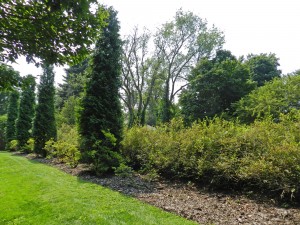Last winter was really hard on many hedges and the forecast for this winter is similar. It’s easy to focus on the exterior of the hedge but don’t neglect the interior. Now is a great time to do this because it’s very obvious which branches are bare to the ground and which are not. Remove all dead wood.

This well maintained Thuja (Arborvitae) hedge was planted on a north/south line so it gets both morning and afternoon sun.
When March finally comes, it will be the perfect time to re-evaluate and prune your hedges. Most evergreen hedges can be trimmed twice a year for shape, in late winter and again in midsummer. Prune most deciduous hedges just once, in late winter/very early spring.
Again, remove any dead wood. Next, when pruning to control width or height, do not just prune to the desired size. Remember that the plant will control to grow from the point at which you pruned. Also, the point at which you prune is where new leaders form.
Now is the time to have your pruners sharpened. You’ll need them for removing the interior deadwood and then, in Spring, you’ll be ready to go again. And, please, use hand pruners, not electric shears. I know that the pruning goes much faster with shears but you will merely be making more work for yourself later.
Did you know that you select the direction of new growth by choosing the leaf above which you prune? This is particularly true of plants with alternate foliage (leaves not side by side). If you prune back approximately three to six inches below the ultimate height you want, that will probably be the height by fall. Part of knowing how much to prune off is knowing how fast that plant tends to grow in a year. The same is true when pruning back a hedge from a sidewalk or bed edge.
Annual pruning will create better airflow to the interior of the hedge, usually a very warm and humid environment in summer—exactly the conditions many garden diseases favor.

This young Vicary privet hedge looks very appealing now but will need a great deal of pruning in the future.
Annual pruning should also keep hedge plants like privet from flowering. That would be a blessing since privet is a prolific seeder and the seedlings have extremely strong roots. On the other hand, if you have a Viburnum hedge and want it to flower, wait until after it blooms to prune. This will, of course, prevent fruit from setting.
Be good to your hedge, starting now.



0 Comments